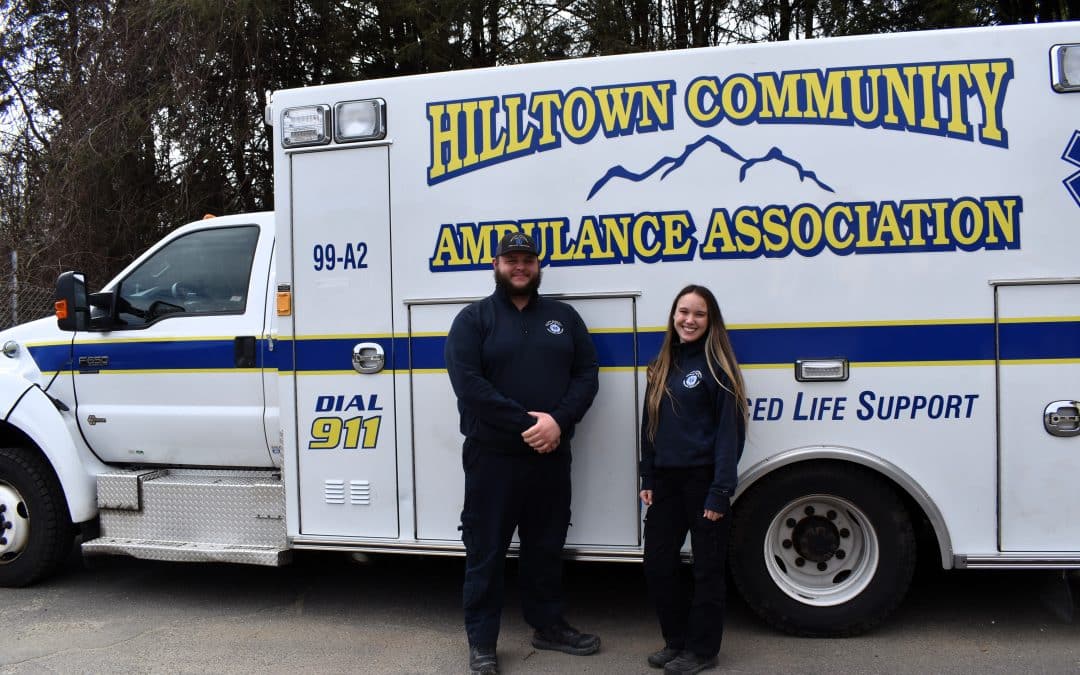Bailey Jones, service director, and Jade Rice, chief financial officer in front of Hilltown Community Ambulance’s newest ambulance, a 2011 Ford 650 purchased last year for $75,000.
Reminder Publishing photo by Amy Porter
HUNTINGTON — Bailey Jones, service director, Jade Rice, chief financial officer, and Mary Ann Pease, president of the board of the Hilltown Community Ambulance Association, are encouraging town officials and members of the community to attend an informational meeting 7-8 p.m. Thursday, April 18, in Stanton Hall. Refreshments will be served.
At the meeting, Ira Brezinsky of the Pioneer Valley Planning Commission will present recommendations from a recent study that looked at how to strengthen the financial condition of the emergency medical service while maintaining or improving the current service level.
After the presentation, Jones, a paramedic, will describe what the ambulance service does when it responds to a call, from when the tones go out until a patient arrives at a hospital. There will also be time for questions and answers.
“We really want people to know what’s going on,” Pease said. “We need their support.”
The Hilltown Community Ambulance Association, headquartered at 1 Bromley Rd. in Huntington, provides emergency medical services to Blandford, Chester, Huntington, Montgomery, Russell and Worthington. A 501c3 nonprofit public safety organization, HCAA is staffed by emergency medical technicians and paramedics, many of whom live in the Hilltowns.
Pease said HCAA is one of the few nonprofit ambulance services in the state, along with Highland Ambulance in Goshen and the Colrain Volunteer Ambulance Service, and as such, requires the support of all six communities that it serves. One reason for the PVPC report, which was funded by a grant, was to find out if there are different models they could consider other than nonprofit, which she said is limiting.
“There is a lot as a nonprofit that we don’t qualify for,” Pease said.
Pease said in most of the communities HCAA serves, there is no industry or heavy commercial tax base, which puts the burden on the residential taxpayers.
“We have been asked for years to keep increases to 2.5%. We no longer can,” she said.
“We’re one of the only full-time ambulances out here, besides the state police,” said Jones, adding, “The big thing for us is sustainability.”
He said the ambulance service needs to cover its weekly expenses along with salaries, and the contracts with the towns don’t cover even half of the annual salaries.
For the past four years, HCAA has been staffed by a mixture of eight full-time, 9.5 part-time and 10.5 per diem paramedics and basic EMTs, according to the report.
Jones and Rice said the payroll per week is $10,000 to $11,000, and each town’s contract covers about a month to a month and half of salaries. The current total from the towns is $293,000, while the cost of business and salaries alone is $600,000. This year’s budget is $800,000.
One of the findings of the report was the need to increase town assessments to realistically reflect the financial and operational needs of the organization.
Last year, all six member towns agreed to a $10 per capita increase in town assessments, and to contribute separately to a capital ambulance replacement fund. This year, HCAA is asking for an approximately $15 per capita increase, to bring assessments to $50.25 per capita.
“Not a random number, the industry standard in the region is about $65 per capita. When we constantly did 2.5% increases — behind the scenes, the equipment was aging out,” Jones said. He said because Hilltown Ambulance is a nonprofit, everything is invested back into the organization.
Currently, two of the heart monitors must be replaced, according to state regulations. The agency sought a state budget earmark of $150,000 for the replacements, but it was reduced to $50,000 during budget negotiations in the State House, then reduced again by $25,000 in Gov. Maura Healey’s midyear budget cuts.
Last year, HCAA purchased a “new to us” ambulance for $75,000. Jones drove down to Jefferson, North Carolina, to retrieve it. Bailey expects to use this 2011 Ford 650 until the end of its 20-year service life in 2031. He said it must pass an annual inspection. The cost of a brand-new ambulance averages $350,000.
In exchange, HCAA pledged to provide paramedic level service at least 78% of the time. This past year, it surpassed that number, providing paramedic service more than 90% of the time, eliminating the need for other ambulance services to “intercept” calls in the Hilltowns.
“If we have to get an intercept [because] no para is on call, they can charge to HCAA up to $500 per call,” said Pease. “Using our paras, intercept went down to zero last year, and cut down on cost per call by $100.” She said costs went down from last year’s average cost of $1,114 per call to $947 per call this year, “saving the community a boatload of money.”
Jones said there are 13 paramedics on the roster, some full-time and some part-time.
“We’ve done our best to cut costs,” he said, but the ambulance service faces challenges in maintaining its equipment, keeping 24-hour staffing, serving an aging population and covering its large service area, stretching over several rural towns from Blandford to Worthington.
“The reality is, if anything were to happen to HCAA, who would answer?” Pease said.
“Everybody calls 911 and assumes the ambulance will show up,” Rice said.


